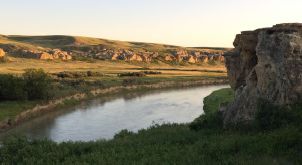
Water musings
November 21, 2024
- •
- •
- •
“The department lacks effective processes to manage surface water allocation and use … Public reporting on surface water and the outcomes of surface water management is lacking.”
By Kennedy Halvorson
Read the PDF version here.
“The department lacks effective processes to manage surface water allocation and use … Public reporting on surface water and the outcomes of surface water management is lacking.”
That’s what the province’s Auditor General concluded in July, after reviewing the government’s planning, licensing, monitoring, and water reporting processes. It’s not a surprising assessment, but a disappointing confirmation nonetheless.
The trend is exemplified in the recently announced Approved Water Management Plan (AWMP) for the Milk River Basin. The strategy for the Milk River is the third of its kind, following the release of the South Saskatchewan River Basin AWMP in 2006, and the Battle River Sub-Basin AWMP in 2014. As one of the key legislative tools under the Water Act, these approved water management plans are binding. They identify relevant information and issues in a region that must be considered when making decisions about water. The plans also typically establish water conservation objectives for the basin, or the minimum flows that must stay in the river to preserve the health of the environment.
The first thing you may clock is the timeline — it is taking almost a decade on average to develop these plans. The second thing to catch is the scale; management plans can be created for both major basins and sub-basins. At the major basin scale, Alberta has five more to complete. If those were completed at the current pace, it would take until 2069 to have full coverage of Alberta watersheds.
As noted by the Auditor General, this is troublesome; while plans and conservation goals for basins are slowly being developed, licences are still being doled out for the rivers’ water. As was the case with the South Saskatchewan, basins can become overallocated and ecologically threatened in that time and the Milk River risks a similar fate.
The Milk, Alberta’s most south-easternly basin, is unique from the others in a few ways. With headwaters originating in western Montana, it is the only major basin that drains southward, ultimately ending up in the Gulf of Mexico. It is the smallest of Alberta’s major basins, with an average annual discharge of 160 billion litres, and the only to have flows that are nearly double of what would occur naturally. This is due to the major diversion the Milk typically receives from the St. Mary River via the USA’s St. Mary Canal.
The Milk and St. Mary Rivers are shared by Canada and the USA. Each country is entitled to half their collective flows, out of whichever river is more beneficial for their desired purposes. This means typically, Canada has agreed to take the majority of our share out of the St. Mary’s, while the USA pulls their majority from the Milk.
In the absence of measured flow needs for the aquatic environment, the Alberta government recommends leaving 85 percent of the water instream. However, Alberta alone consumes about 20 percent of the Milk’s flow, and as illustrated by the Auditor General’s report, does not have effective processes to determine how this could be impacting the environment. With the AWMP now in effect, the next step for the Milk will be to determine water conservation objectives, but because they do not apply retroactively, water already allocated cannot be clawed back.
The Milk’s AWMP also recommends developing a water shortage strategy in the event of low flow or drought conditions. However, further exemplifying Alberta’s water management issues, this recommendation comes too late. The Milk River Basin just received enough moisture to end its latest multi-year drought, only for low flows to return anyway because of a structural failure at the USA’s diversion point. On June 17, part of the St. Mary’s Canal burst, causing local flooding and erosion, substantially reducing the expected flows in the Milk, and extending water advisories for downstream communities.
While every new water management plan is a step in the right direction, AWA agrees with the Auditor General; Alberta must do better. Effective water conservation and management is needed now more than ever to weather future challenges.
